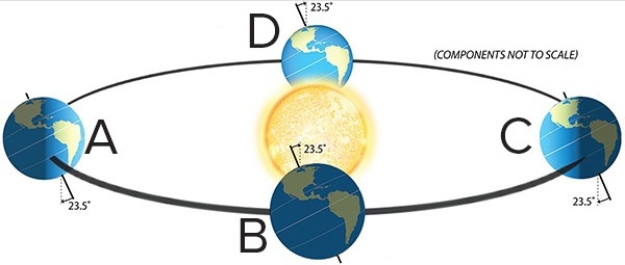A) troposphere; decrease; ultraviolet rays
B) ozone; increase; gamma rays and x rays
C) stratosphere; decrease; ultraviolet rays
D) thermosphere; increase; gamma rays and x rays
F) A) and B)
Correct Answer

verified
Correct Answer
verified
Multiple Choice
The most common component of the atmosphere is
A) nitrogen.
B) carbon dioxide.
C) particulates.
D) aerosols.
F) A) and C)
Correct Answer

verified
Correct Answer
verified
Multiple Choice
During the June solstice,the circle of illumination completely shades out
A) points south of the Antarctic Circle but completely illuminates points north of the Arctic Circle.
B) points north of the Arctic Circle but completely illuminates points south of the Antarctic Circle.
C) points south of the Arctic Circle but completely illuminates points north of the Antarctic Circle.
D) points north of the Antarctic Circle but completely illuminates points south of the Arctic Circle.
F) B) and D)
Correct Answer

verified
Correct Answer
verified
Multiple Choice
Most energy entering the earth's atmosphere is between ________ and ________ microns while most of the thermal infrared energy emitted from the earth is between ________ and ________ microns
A) 20; 40; 40; 60
B) 8; 13; 20; 40
C) 0.1; 0.4; 8; 13
D) 0.4; 0.7; 8; 20
F) All of the above
Correct Answer

verified
Correct Answer
verified
Multiple Choice
Which of the following involves the release of latent heat back into the environment?
A) Evaporation
B) Deposition
C) Melting
D) Sublimation
F) A) and C)
Correct Answer

verified
Correct Answer
verified
Multiple Choice
All of the following is true in regard to the earth's radiation balance except
A) at around 35°,incoming insolation is roughly balanced with outgoing longwave radiation.
B) poleward of 35° regions emit more outgoing longwave radiation than they receive as insolation.
C) outgoing longwave radiation increases poleward in regular increments,peaking at the poles.
D) equator,tropics,and subtropics receive more insolation than what they emit as outgoing longwave radiation.
F) C) and D)
Correct Answer

verified
Correct Answer
verified
Multiple Choice
What is the approximate percentage of insolation arriving at the top of the atmosphere that is absorbed by the ground?
A) 20%
B) 40%
C) 50%
D) 70%
F) B) and D)
Correct Answer

verified
Correct Answer
verified
Multiple Choice
North America is farthest from the Sun during
A) perihelion,which occurs in early July.
B) perihelion,which occurs in early January.
C) aphelion,which occurs in early July.
D) aphelion,which occurs in early January.
F) A) and C)
Correct Answer

verified
Correct Answer
verified
Multiple Choice
North America is closest to the Sun,during
A) perihelion,which occurs in early July.
B) perihelion,which occurs in early January.
C) aphelion,which occurs in early July.
D) aphelion,which occurs in early January.
F) C) and D)
Correct Answer

verified
Correct Answer
verified
Multiple Choice
On equinox,
A) points north of the Arctic Circle receive 24 hours of daylight
B) tilt is neither inclined toward or away from the sun
C) points south of the Antarctic receive 24 hours of daylight
D) points north of the Arctic Circle and Antarctic Circle receive 24 hours of darkness
F) A) and B)
Correct Answer

verified
Correct Answer
verified
Multiple Choice
Where do the highest amounts of insolation reach the surface based on more absorption and less scattering? 
A) A
B) B
C) C
D) D
F) B) and D)
Correct Answer

verified
Correct Answer
verified
Multiple Choice
On what day does the Sun have its highest Sun angle and sets/rises farthest north?
A) Winter solstice
B) Spring equinox
C) Fall equinox
D) Summer solstice
F) B) and C)
Correct Answer

verified
Correct Answer
verified
Multiple Choice
The most important greenhouse gas for retaining a variety of outgoing longwave radiation is
A) CH₄.
B) N₂O.
C) H₂O.
D) CO₂.
F) A) and D)
Correct Answer

verified
Correct Answer
verified
Multiple Choice
All of the following involve the input of energy except.
A) melting.
B) evaporation.
C) freezing.
D) sublimation.
F) A) and C)
Correct Answer

verified
C
Correct Answer
verified
Multiple Choice
Base the following questions on the climographs and insolation graphs below.Letters represent a location where the climograph and insolation graph were recorded. 


 -Which of the following was NOT discussed in the opening two-page spread of the Energy and Matter chapter?
-Which of the following was NOT discussed in the opening two-page spread of the Energy and Matter chapter?
A) Sunlight
B) Tropical regions
C) Clouds
D) Seasons
E) All of these choices are correct
G) A) and C)
Correct Answer

verified
Correct Answer
verified
Multiple Choice
Which of the letters represents the summer solstice for the Northern Hemisphere? 
A) A
B) B
C) C
D) D
F) All of the above
Correct Answer

verified
Correct Answer
verified
Multiple Choice
All of the following will warm the local environment except
A) deposition.
B) evaporation.
C) freezing.
D) condensation.
F) All of the above
Correct Answer

verified
Correct Answer
verified
Multiple Choice
Which of the following is true regarding phase changes?
A) Energy is released when going from higher to lower energy state.
B) Energy is required to go from a higher to lower energy state.
C) All phase changes involve the release of energy.
D) All phase changes require energy absorption.
F) A) and C)
Correct Answer

verified
A
Correct Answer
verified
Multiple Choice
Which of the following processes is primarily responsible for the sky's blue color?
A) Absorption
B) Scattering
C) Reflection
D) Filtering
F) A) and C)
Correct Answer

verified
B
Correct Answer
verified
Multiple Choice
Ozone
A) is formed mainly in the troposphere where it diffuses to the stratosphere.
B) is only formed through natural processes.
C) is destroyed by halogens in chlorofluorocarbons.
D) is only destroyed through natural processes.
F) B) and C)
Correct Answer

verified
Correct Answer
verified
Showing 1 - 20 of 81
Related Exams